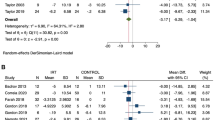Abstract
Meditation training appears to be a promising psychological approach to the control of hypertension. However, most studies to date have had serious deficiencies. This study attempted to correct many of these deficiencies. Forty-one unmedicated hypertensives referred by general practitioners were randomly allocated to three groups. The treatment group (SRELAX) underwent training procedures based on Transcendental Meditation; a placebo control group (NSRELAX) underwent identical training but without a mantra. Both procedures were compared with a no-treatment control group. The results showed modest reductions in blood pressure in both SRELAX and NSRELAX groups, compared with the no-treatment controls, with diastolic percentage reductions reaching significance (p<0.05). There was considerable subject variation in response, with overall a mean decline in diastolic blood pressure of 8–10% on 3-month follow-up. Possible indicators to predict the response of subjects are considered and reasons for the similarity in the effectiveness of the SRELAX and NSRELAX conditions are discussed.
Similar content being viewed by others
References
Aitken, R. C. (1969). Measurement of feelings using visual analogue scales.Proc. R. Soc. Med. 62: 989–993.
Benson, H., Rosner, B. A., Marzetta, B. R., and Klemchuck, H. M. (1974a). Decreased blood pressure in pharmacologically treated hypertensive patients who regularly elicited the relaxation response.Lancet, February, 289–291.
Benson, H., Rosner, B. A., Marzetta, B. R., and Klemchuck, H. M. (1974b). Decreased blood pressure in borderline hypertensive subjects who practice meditation.J. Chron. Dis. 27: 163–169.
Blackwell, B., Bloomfield, S., Gartside, P., Robinson, A., Hanenson, L., Magenheim, H., Nidich, S., and Zigler, R. (1976). Transcendental meditation in hypertension: Individual response patterns.Lancet 1(7953): 223–226.
Blanchard, E. B., and Miller, S. T. (1977). Psychological treatment of cardiovascular disease.Arch. Gen. Psychiat. 34: 1402–1413.
Derogatis, L. R., Lipman, R. S., Rickels, K., Uhlenhuth, E. H., and Covi, L. (1974). The Hopkins Symptom Checklist (HSCL): A measure of primary symptom dimensions. In Pichot, P. (ed.),Psychological Measurements in Psychopharmacology: Modern Problems in Pharmacopsychiatry, Vol. 7, Karger, Basel.
Geddes, L. A. (1970).The Direct and Indirect Measurement of Blood Pressure, Year Book Medical Publishers, Chicago.
Jacob, R. G., Kraemer, H. C., and Agras, W. S. (1977). Relaxation therapy in the treatment of essential hypertension.Arch. Gen. Psychiat. 34: 1417–1427.
Krausman, D. T. (1975). Methods and procedures for monitoring and recording blood pressure.Am. Psychol. 30: 285–294.
Lader, M. H., and Wing, L. (1966).Physiological Measures, Sedative Drugs, and Morbid Anxiety, London University Press, London.
Maharishi Mahesh Yogi (1968).Meditations of Maharishi Mahesh Yogi, Bantam Books, New York.
Naranjo, C., and Ornstein, R. E. (1971).On the Psychology of Meditation, Viking Press, New York.
Patel, C. H., and North, W. R. S. (1975). Randomised controlled trial of yoga and biofeedback in management of hypertension.Lancet Suppl. 48: 171–174.
Pollack, A. D., Weber, M. A., Case, D. B., and Laragh, J. H. (1977). Limitations of transcendental meditation in the treatment of essential hypertension.Lancet, January 8, 71–73.
Rotter, J. B. (1966). Generalized expectancies for internal versus external control of reinforcement.Psychol. Monogr. 80: Whole No. 609, 1–28.
Smith, J. C. (1976). Psychotherapeutic effects of transcendental meditation with controls for expectation of relief and daily sitting.J. Consult. Clin. Psychol. 44: 630–637.
Spielberger, C. D., Gorsuch, R. L., and Lushene, R. E. (1970).STAI Manual for the Stait-Trait Anxiety Inventory (“Self Evaluation Questionnaire”), Consulting Psychologists Press, Palo Alto, Calif.
Stone, R. A., and DeLeo, J. (1976). Psychotherapeutic control of hypertension.New Engl. J. Med. 294: 80–84.
Surwit, R. S., Hager, J. L., and Feldman, T. (1977). The role of feedback in voluntary control of blood pressure in instructed subjects.J. Appl. Behav. Anal. 10: 625–31.
Surwit, R. S., Shapiro, D., and Good M. I. (1978). Comparison of cardiovascular biofeedback, neuromuscular feedback, and meditation in the treatment of borderline hypertension.J. Consult. Clin. Psychol. 46: 252–263.
Wilder, J. (1956). The law of initial value in neurology and psychiatry: Facts and problems.J. Nerv. Ment. Dis. 125: 73–86.
Wright, B. M., and Dore, C. F. (1970). A random-zero sphygmomanometer.Lancet 1: 337–338.
Author information
Authors and Affiliations
Additional information
This research was funded by a grant from the Auckland Medical Research Foundation.
Rights and permissions
About this article
Cite this article
Seer, P., Raeburn, J.M. Meditation training and essential hypertension: A methodological study. J Behav Med 3, 59–71 (1980). https://doi.org/10.1007/BF00844914
Accepted:
Issue Date:
DOI: https://doi.org/10.1007/BF00844914




